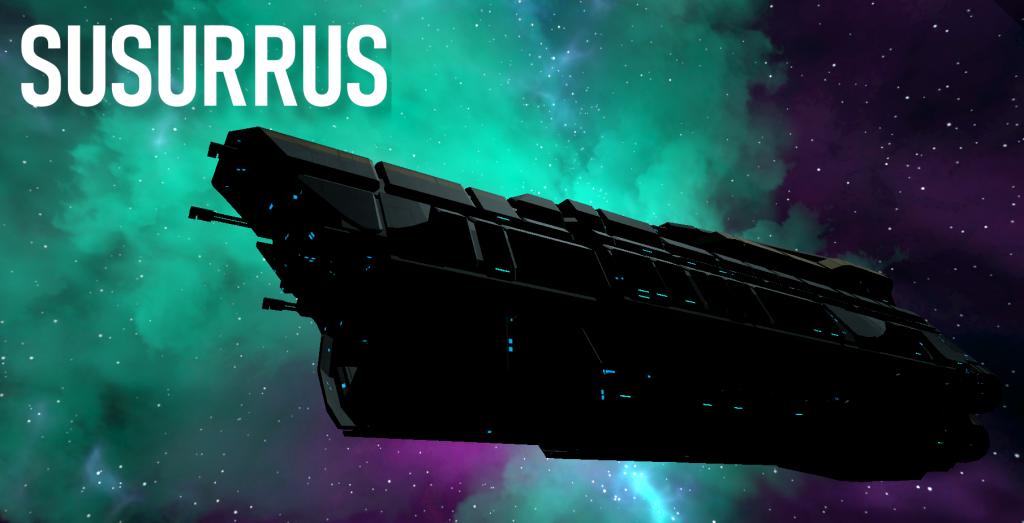
Adventure Jam 2020 post-mortem
The game jam
This year I took part in my first ever game jam. For those who don’t know, a game jam is when you have to create a game to fit a given theme or game mechanic in a limited amount of time. This is often 24 or 48 hours, but in this case I had two weeks.
I heard about Adventure Jam 2020 via AdventureX, who had to cancel their conference in London this year. Side note: I went last year, it was ace! Anyway, they said they would be running a game jam in November instead, but also linked to the Adventure Jam which was a couple of weeks away, and I ‘signed up’ immediately.
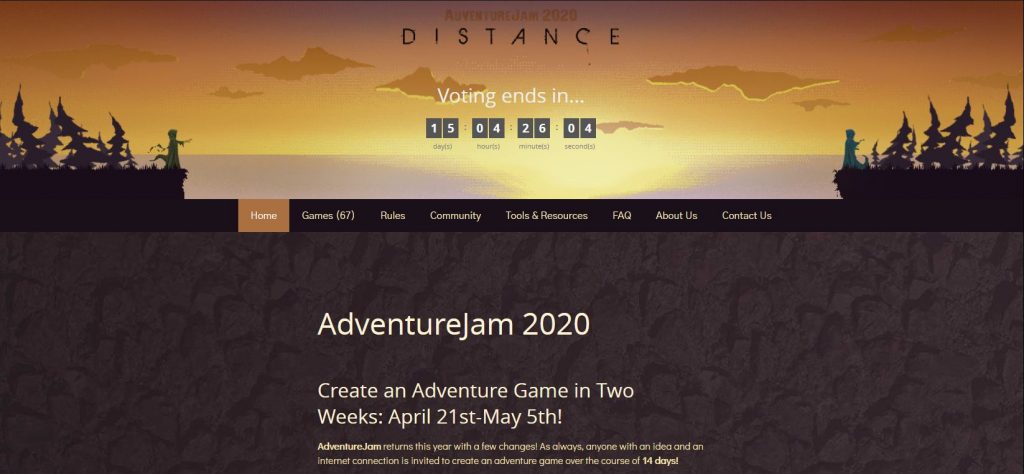
This years’ theme was Distance, because of things happening in the world, but was extended to include contrasting themes such as community and reunion, and also opened out to any theme at all. The organisers didn’t want to confine participants to a theme that might resonate a bit too vividly at the moment, and at the same time they removed the judging part of the process, leaving the games to be played and voted on by those taking part instead.
Luckily I came up with an idea pretty quickly. Inspired by watching both ‘Passengers’ (better than expected), and ‘Alien: Covenant’ (as bad as expected) for the first time recently, I decided that my game would be about an engineer called Sam, who was all on his own on a deep space colony ship. It would jump back and forth in time between the ‘past’, where all the crew were awakened for their last physical set of checks on the ship before going back into stasis, and various dates in the ‘future’ after something goes badly wrong, and he volunteers to stay awake for the remaining 23 years of the trip to carry on with maintenance.


The plan
So, with the general idea in place, I set about making a plan for the 14 days I would have to make this thing. By the way, this was allowed. While we were not permitted to begin writing, coding or making/sourcing assets for the game, we were allowed to create a work plan and figure out what was needed, and I created a fairly simple one.
Given the idea was to contrast the past and present with each other, and that outside of some special scenes, Sam would meet and chat to each of the other 5 crew members in turn, I was able to work out how many locations I would need, and how many scenes would take place across these locations.
In total I would need 8 locations (game levels) and for the full story there would be 26 scenes (involving conversations and gameplay puzzles) across these locations. Which I thought was doable in the time. Oh, sweet, innocent child…

As well as the conversations, which were the ‘meat’ of the game, there would be puzzles based around Sam being an engineer. So, puzzles to fix broken things and use physical and digital tools to perform general maintenance checks. These puzzles were designed to make the player feel like they were going through the same routine as Sam, as he tried to keep a hold on his sanity.
And speaking of sanity, another key idea was his task list. This would be a PDA he would have on him at all times, where he would compulsively write down lists of things to do – both maintenance work, and real life stuff. In the ‘past’ the crew would gently rib him for this, but as his isolation progressed, it would become an extension of his declining mental state. The player would be forced to tick off tasks as they were done before they would be allowed to continue, to show how Sam was becoming increasingly obsessive. And eventually, if the player forgot to tick off a task, or tried to tick it before it was done, Sam would become explosively angry, berating himself for not keeping to his routine.
So, with all the main gameplay elements laid out, it was time to start making it!

What went right
I made a plan!
It took me a few days to wrangle my story into a coherent set of scenes, which was made more complex because the story involved jumping back and forth in time, but when I finally did it, it was a huge relief to see that it all fitted together. And, as mentioned above, it allowed me to visualise the structure of the game ahead of making it.
I knew what tools I was going to use
From the start I knew I would be using the Unity game engine, the Dialogue System for Unity to create the conversations and associated logic, and the PlayMaker visual scripting tool for doing the programming of the game.
I used these mainly because I am very familiar with all three, as I have done other game prototypes using the same tools. I discounted using the Unreal engine as there is no comparable dialogue tool, and while I can use its Blueprint visual scripting tool, I have a strong dislike for it, as it always feels I’m working backwards through a problem, rather than logically forwards. And there is also the fact it doesn’t automatically give you the correct input to some nodes when there is only one possible input, gives you no idea what this required input might be, and often the documentation doesn’t even tell you what it should be…
Yeah, I have some ‘issues’ with Blueprints 🙂 PlayMaker much more closely matches how I logically think about solving problems, and was a vital tool.


I used pre-made assets
I am a frequent browser of the Unity asset store and had noticed the Synty POLYGON art assets many times. These are deliberately low-poly, blocky art assets of characters and objects covering various themes, such as Medieval, War, City, and, the one I ended up using, Sci-Fi.
I had often wondered who would actually buy and use these in a commercial game, as they are far too visually distinctive, but it turns out that they are ideal for prototypes and for game jam games!
There was no way I would be able to make any art assets myself, having neither the tools nor the expertise, and although as part of the game jam you could ‘advertise’ for artists to help you out, this being a 3D game meant it would require a heck of a lot of unique assets.
So, when I settled on my game idea and spotted the Sci-Fi art pack in a sale, I figured I might as well. Actually, I figured that I had to, as there would be no other way I could make the game!


I had a full logic playthrough at day 7
Just using single flat cube levels and triggers, I was able to get the correct levels loading in the right order and create a ‘logic playthrough’ from start to finish at day 7. This felt like quite an achievement at the time, and definitely spurred me on for the final week.
I decelerated towards the end
Come day 11, and realising I would have to do a second round of scene cutting (see below) as well as make sure the game could be built and uploaded to the website in time, I decided to slow things down.
I had spent about 8+ hours a day for the previous 10 days on this game, and was getting to a point where I was working less and less effectively as I went on. So, I cut right back in terms of what I had left to make, set aside a day for playtesting, fixing bugs, and making sure the upload worked, and gradually reduced the hours I was spending on it.
In the end, the final couple of days were pretty relaxed, and I was glad I ended the project in this way, and not frantically shoving in content at the last minute. It also allowed me to add in some music and audio, which I had almost forgotten about, which helped enhance the final mood of the game.
What went wrong
I didn’t plan!
Hang on, I just said above that I did? Well, ‘plan’ in this context refers to a technical plan. I had figured out all I needed for the story to work, but I hadn’t laid out what I would need for the game to work, and this ended up costing me a lot of time.
While I thought I was making good progress creating an inventory, making doors open if the player had a key, etc., I hadn’t worked out in advance how I wanted to achieve these features. This meant a lot of trial and error, and a lot of failing to get them to work, and all of this failing and experimentation cost me time.
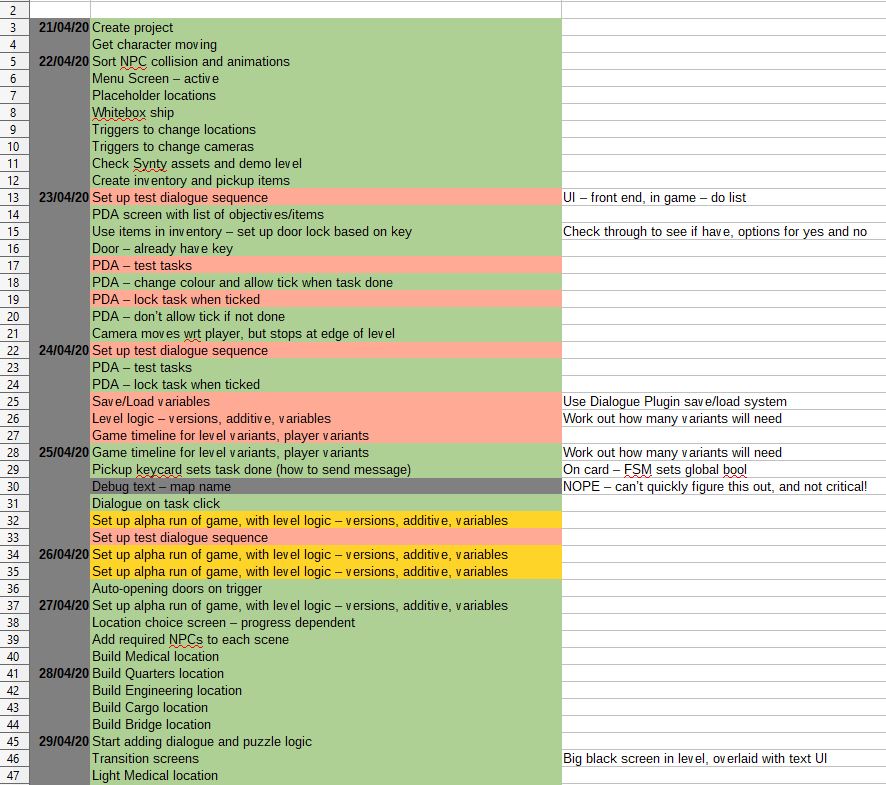
I had a full logic playthrough at day 7
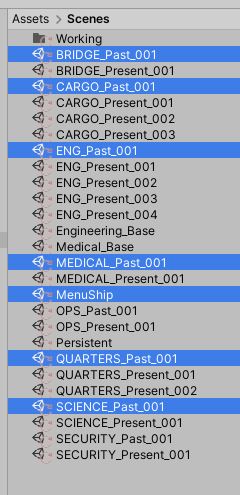 Hang on, deja-vu and all that… Yes, while it was comforting to be able to run through the full game by this point, it was way too late. If I had started this task first, I would been forced to figure out how I was going to effectively re-use the game levels.
Hang on, deja-vu and all that… Yes, while it was comforting to be able to run through the full game by this point, it was way too late. If I had started this task first, I would been forced to figure out how I was going to effectively re-use the game levels.
Also, if I had spent some of my pre-planning time figuring out how I was going to manage multiple scenes sharing the same level, then spent the first few days getting this playthrough up and running, I would have saved at least a whole day or two of development.
I had no idea how long each scene would take to make
Given all the above, I didn’t start the actual creation of the scenes until day 9 of 14, meaning I had no idea how long it would take to create a single scene until then. It turned out tha I could make about 4 in one day, so if I did nothing else but make scenes I could do 20 out of 23 in the final 5 days. Except I had more to do than just make scenes, which meant I had to start pruning. I did two passes of this, the first cutting it down to 18 scenes, then finally down to 14.
While I did manage to retain the key elements of the plot, and you might think this should be in the ‘what went right’ section, ultimately I was disappointed to lose most of the story.
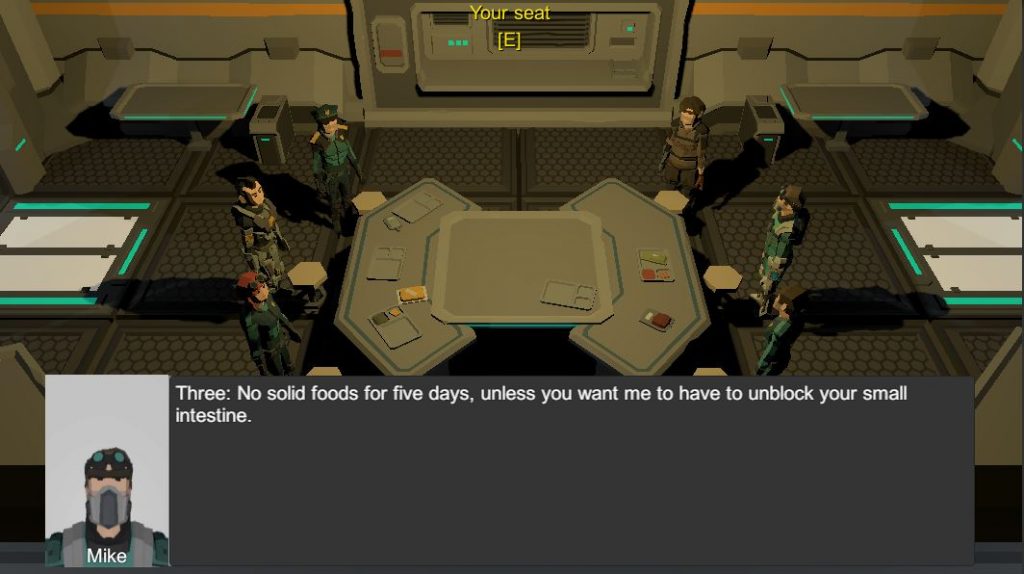
The story suffered
Talking of story, the story that is in there now feels overly simplistic and very clunkily arrives at the ‘emotional payoff ending’. Also, one scene in the middle was extended to include necessary exposition that would otherwise have been spread out across scenes that were cut, and it ends up being overlong.
Not only that, while I spent an entire day and a half of the 14 available making the PDA task list work properly, in the end it was never used as intended. I simply ran out of time to hook in Sam’s mental state to the tasks. And in any case, this was supposed to be a gradual psychological decline as time went on, but with so many transitional scenes having to be lopped off, there was no gradual decline to show. The list remains as an optional part of the game, like your appendix. Or one kidney.
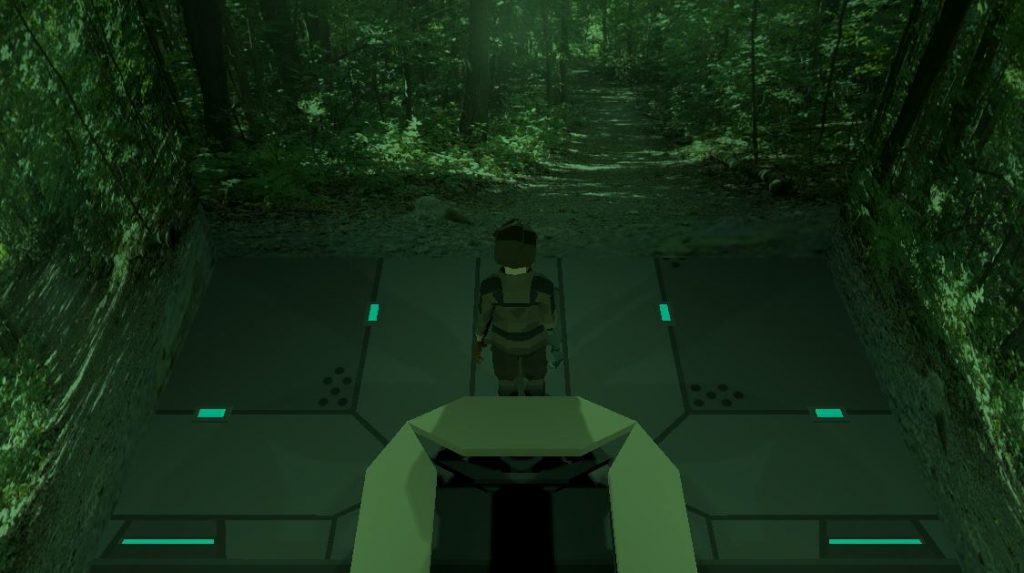
There are no puzzles
Yes, for an adventure game, it has very few puzzles. This was again another victim of running out of time from spending too long on features that were ultimately not used fully.
As mentioned above, Sam was to have maintenance tasks to do in most scenes, and you do get one to perform in the Engineering and Cargo areas in the current version. But, as with the scenes themselves, I had no idea how long these would take to create until I started making them. It turned out the answer was ‘too long’, and I quickly had to drop most of these to focus on what was left of the story.
Lessons learned
While I’m ultimately very happy with what I made in two weeks, which is pretty ridiculous given I’ve never made a complete game before in my life, I’m still disappointed with how I approached it.
While the story planning went well, and allowed me the flexibility to cut scenes while still keeping the core story intact, the technical planning was minimal. In future I will make sure I spend as much time on this part of the process as I do the story.
The Synty assets were a lifeline. Without these there would simply be no game right now, and they actually fit the tone of the game surprisingly well.
I’m also happy with how the levels worked out, as I designed each of them from scratch. Well, all apart from Hydroponics, which is a direct cut-and-paste from the Synty demo map, as I was running out of time! I will redesign this to my own requirements at a later date.
And yes, I do want to finish this game properly! Over half the intended content is still missing, and I want to give the full story justice. While I can’t add any extra content until the voting period is over, I am planning to slowly insert the missing scenes and locations over the coming months.
Oh, and if you’re wondering about the name, ‘Susurrus’, I follow Susie Dent on twitter, the lexicographer and etymologist on the TV show Countdown, and literally the day the game jam was due to start, she tweeted a few of her favourite words. One of them was ‘susurrus’, which is a ‘soft rustling sound’ like wind through leaves. This fitted perfectly with a running theme in my story, and instantly became the title.
Tony.
